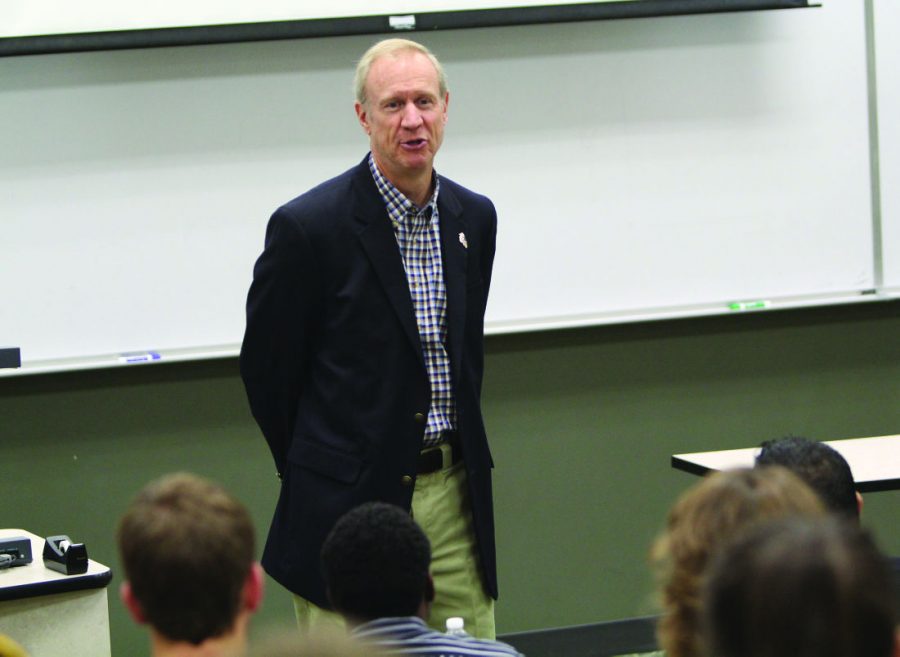Ill. Community College System’s 50th anniversary met with enrollment, funding troubles
Republican gubernatorial candidate Bruce Rauner speaks to business students Aug. 29 in Barsema Hall. Rauner gave advice on investing in start-up businesses and discussed how he will use his experience in venture capitalism to promote job growth in Illinois if elected in November. “My favorite people in the world are entrepreneurs,” Rauner said. “They take risks, take a lot of grief. They have to be lucky, but they also have to be smart and good and tough, and it’s all about team building.”
September 24, 2015
It is the year of the community college, according a declaration by Gov. Bruce Rauner in honor of the 50th anniversary of the Illinois Community College System, which includes Kishwaukee Community College.
On average, 63 percent of Kishwaukee’s transfer program graduates attend NIU. Additionally, a large portion of nongraduates transfer to NIU, according to Kishwaukee’s Institutional Research.
Since the inception of the state’s community college system on July 15, 1965, it has expanded to the third largest in the nation, encompassing 48 colleges and one multi-community college center in 39 districts, according to the Illinois Community College Board website. The system serves close to one million students annually.
“For a lot of people it is very difficult to afford higher education,” said Thomas Choice, Kishwaukee Community College president. “You know what it costs to go to NIU — and NIU is reasonably priced for a university in Illinois — but for some, that is out of reach. Community colleges provide an affordable alternative.”
Cost up, enrollment down
Between the 2004-05 and 2014-15 academic years, the average published tuition and fees at public two-year colleges increased by 28 percent, or $730 after adjusting for inflation, according to a College Board survey.
“It has been up and down with enrollment. We have had significant enrollment increases, and now in the last few years, across the state in two-year and four-year schools, there have been declines,” Choice said. “The finances have gone up and down, too, as the state has had budget issues. It’s impacting everybody. We’ve had to scale back some programs and services to make sure we are still operating with a balanced budget.”
Rauner’s Fiscal Year 2016 proposed budget includes a 30 percent reduction in funds to public universities. A lack of agreement on a budget has resulted in an almost three-month impasse. Without a finalized budget, Monetary Award Program funds cannot be appropriated.
MAP provides grants to Illinois residents who attend approved Illinois colleges and demonstrate financial need based on the information provided on the Free Application for Federal Student Aid.
“Unfortunately there is no movement on the budget,” said Rep. Bob Pritchard (R-Hinckley). “The governor’s staff has taken the position that we have to have a budget that deals with all of higher ed, not just MAP grants, or we will be shorting the universities in what we can give in MAP grants. As you know, MAP grants go to private institutions, as well as public institutions. So there’s a feeling that we don’t want to start with the MAP grants and have to cut the public institutions’ to get the budget.”
More than 320 students qualify for MAP grants at Kishwaukee Community College, Choice said.
“They are the life blood of so many of our students,” Choice said. “It’s the books, childcare, transportation. Without those things they can’t come to school and that impacts us quite a bit. Of those students there are 30 that the Pell Grants don’t cover all the tuition. We have deferred their payments to this point, but we can’t defer it forever.”







